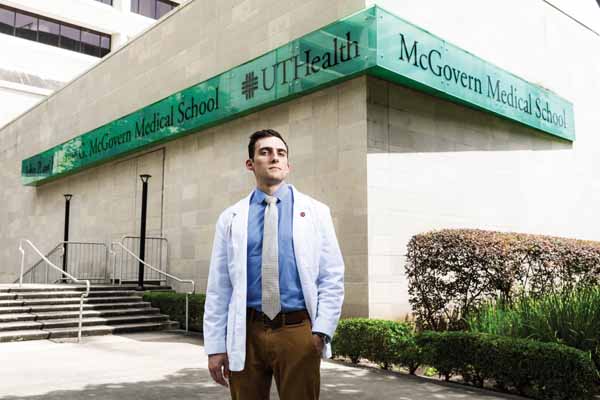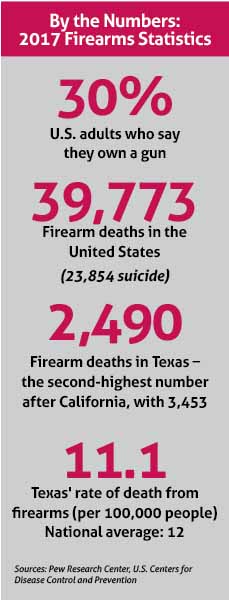
Michael Bagg was bothered by how his fellow students at McGovern Medical School at UTHealth in Houston reacted to the 2017 Las Vegas shooting, which killed 58 people.
They simply didn’t talk about it.
“I didn’t see any [acknowledgement] that the largest mass shooting in U.S. history had just happened,” said Mr. Bagg, a third-year medical student at McGovern Medical School. “I was very frustrated by the lack of conversations in a health care setting because we’re the ones treating these injuries.”
He started talking with a classmate about ways to address firearms that would improve safety while also respecting the rights of gun owners. Together, they came up with a preclinical curriculum for an elective class on firearms safety that has been taught at the school for the past two years. The course, which more than 100 students have attended, addresses topics such as the treatment of injuries and threat identification.
Mr. Bagg’s work helped him win the 2019 Texas Medical Association Medical Student Section Student of the Year Award.
The silence about firearms Mr. Bagg observed at school has been reflected in other parts of the medical world as well, says Sandra McKay, MD, an assistant professor of pediatrics at McGovern Medical School who served as Mr. Bagg’s faculty advisor. Physicians often are reluctant to initiate any conversation about firearms with patients because it’s a deeply emotional topic, she says.
For instance, a 2016 study by Epidemiologic Review analyzed 72 articles on clinician practice patterns and found that physicians seldom screen or counsel their patients – even high-risk patients – about firearms safety. One of the articles, a 2014 survey, found that 80% of hospital internists reported never assessing patients’ gun access, and 77% reported never discussing firearm injury prevention.
Addressing firearm safety can raise tough questions for physicians, Dr. McKay says.
“How do you keep your focus on patient safety and remove the highly charged political rhetoric that can sometimes be involved with that?” she said. “How do you navigate through there in a professional, non-biased manner?”
The best way is for physicians to approach firearms as a public health issue, says Sue Bornstein, MD, executive director of the nonprofit Texas Medical Home Initiative and a member of the TMA Board of Trustees. It’s important for physicians to talk about firearms safety with evidence-based information just as they do other common injury risks, like motor vehicles, swimming pools, trampolines, and bicycles.
That public health approach is outlined in TMA firearms policy the House of Delegates recently updated at TexMed 2019. Among other things, TMA policy calls on physicians to speak out about preventing firearm injuries and deaths, promote firearms safety programs, and encourage the safe storage of firearms by patients and in the home. It also calls for physicians to support the unfettered scientific study of firearms issues and participation by Texas in gathering data on the topic (www.texmed.org/FirearmsPolicy).
“This is a public health issue. In this country, we’ve dealt with serious public health issues (like seatbelts in cars and tobacco), and we’ve had really good outcomes,” said Dr. Bornstein, who helped author American College of Physicians policy addressing firearm violence. “Physicians have a special responsibility to speak to our patients … about ways to reduce injuries and deaths from guns.”
Safety first
In that vein, Mr. Bagg and his classmate tailored “Gun Violence and Physicians,” a six-session firearm safety class that avoids political discussions about guns and focuses on issues that help physicians treat patients. (See tma.tips/FirearmsClass.)
For instance, lecturers like Dr. McKay discuss what type of people are most likely to commit gun violence and how physicians can assess them. The class also explains things like the damage inflicted on the body by a bullet, how to work a gun lock, and how to talk to patients about safe storage. It stays away from the pros and cons of gun ownership and focuses on ways physicians can mitigate the risks tied to guns.
Some medical students and physicians fear legal repercussions for talking about firearms, Mr. Bagg says. This stems mostly from a 2011 Florida law that banned physicians there from asking patients about gun ownership. Federal courts overturned the law in 2017, but it was widely seen as having a chilling effect on physicians who want to talk to patients about gun safety.
“We want our physicians to know about that – that there is a legally protected right to talk about firearms,” Mr. Bagg said.
The course also explores the lack of national research on firearms. In 1996, a U.S. budget amendment stated, “None of the funds made available for injury prevention and control at the Centers for Disease Control and Prevention (CDC) may be used to advocate or promote gun control.” The “Dickey amendment,” named after U.S. Rep. Jay Dickey (R-Arkansas), was expanded to include the National Institutes of Health in 2011.
This lack of funding has greatly curtailed, though not eliminated, research on firearms issues, Mr. Bagg says. That, in turn, has hampered efforts to make the ownership and use of firearms safer.
“Right now, if you look for information about how physicians should talk to their patients about guns, there’s not a lot out there,” he said. “It’s almost nonexistent.”
Most physicians also get little training in how to address firearms, Mr. Bagg says. A systematic review of literature conducted by Academic Psychiatry in 2016 found only four courses on firearms safety for all health care professionals in undergraduate, graduate, and continuing medical education. Some courses, like Mr. Bagg’s, have been added since, but relatively few medical schools include the topic in their curricula.
Physicians who want to talk to patients about firearms can get help from professional groups like the American Academy of Pediatrics (tma.tips/AAPgunsafety) and the American College of Physicians (tma.tips/ACPgunsafety), as well as from colleagues in discussing the best approach with patients, says Austin pediatrician Kimberly Avila Edwards, MD.
“The most important thing is respect and partnering [with the patient],” she said. “The issue is not to convince or sway your patients on your own personal views about firearms. It’s a conversation about firearm safety, and those are two distinct conversations.”
Assessing risk
Mr. Bagg says his class is aimed at all specialties, but children often come to mind first when it comes to gun safety. In part, that’s because firearms are the second-leading cause of injury-related death in children 1-17 years old, surpassed only by motor vehicle injury deaths, according to a 2017 study in the journal Pediatrics.
 Encouraging safe gun storage is a linchpin of the public health approach to firearm safety. Many parents are overconfident about their ability to hide guns from their children, says Gary Floyd, MD, a Keller pediatrician. He’s a member of the TMA Board of Trustees and chaired the workgroup that updated TMA firearms policy.
Encouraging safe gun storage is a linchpin of the public health approach to firearm safety. Many parents are overconfident about their ability to hide guns from their children, says Gary Floyd, MD, a Keller pediatrician. He’s a member of the TMA Board of Trustees and chaired the workgroup that updated TMA firearms policy.
Almost 40% of parents erroneously believe their children are unaware of the storage location of household guns, and 22% of parents wrongly believe that their children have never handled household guns, according to a 2017 study published by Hospital Pediatrics.
“When there’s a small toddler and a bigger brother or sister [at an office visit], I’ll ask [the older sibling], ‘Do you know where the guns are?’ and they’ll say, ‘Yes,”’ Dr. Floyd said. “And when I ask them, ‘Have you held that gun?’ to parents’ surprise, many times the kids say, ‘Yes. I have.’”
Dr. Edwards has been a pediatrician for 17 years, but she only began asking parents about gun ownership about five years ago. She didn’t know what to expect when she started, but so far the responses from parents have been positive.
“I’ll start by asking if they have firearms, and then I ask them if I can share some information,” she said. “Physicians just can’t have any hesitancy on this issue. In a nonjudgmental manner, they need to provide the best practices for firearm safety.”
The issue of firearm violence goes beyond children, says Dr. Bornstein. Adults with substance use disorders and dementia often need to have their access to firearms removed for their own safety.
Mental illness also can play a role, but Dr. Bornstein says the connection between gun violence and mental illness has been exaggerated to some extent. She cited a February 2019 study by the University of Texas Medical Branch at Galveston that examined the association between gun violence and mental health in a group of 663 young adults in Texas. Published in Preventive Medicine, it found that most mental health symptoms had nothing to do with firearm violence.
“It turns out really there is a very small group of people who have severe persistent illness who are at risk [of committing gun violence],” she said.
People who die by suicide account for 60% of U.S. gun deaths, according to CDC, and primary care physicians have a direct role in preventing suicides, Dr. Bornstein adds. (See “Front Line: Using Primary Care to Prevent Suicide,” November 2018 Texas Medicine, pages 16-21, www.texmed.org/FrontLine.)
“Ensuring that our patients practice safe storage of firearms, assessing risk of firearm injury for household members, and recognizing the critical role of firearms in suicide are all in the purview of the physician,” she said.
Mr. Bagg and his classmate are handing off the “Gun Violence and Physicians” course to incoming second-year students, and the goal is to pass it down from class to class. Meanwhile, students from nearby Baylor College of Medicine have begun to take the McGovern course, and Mr. Bagg is hopeful other medical schools will adopt similar courses for their students.
Tex Med. 2019;115(8):42-44
August 2019 Texas Medicine Contents
Texas Medicine Main Page